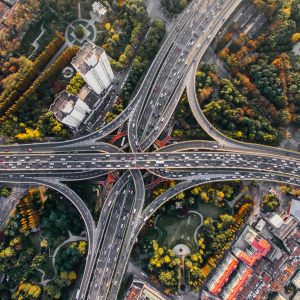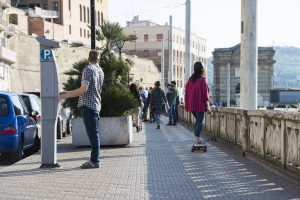If there’s one thing that almost everyone can agree on, it’s that sitting in rush-hour traffic is not fun. Yet, three-quarters of Americans drive themselves to and from work, according to the U.S. Census Bureau. Beyond being a daily headache, commuting actually has a major impact on the Earth’s atmosphere and environment.
The impact of driving to work
Commuting to work accounts for nearly all of an individual employee’s job-related carbon footprint. A look at the CO2 emissions resulting from commuting by car shows that individual choices can have a big impact.
The average American commute is around 15 miles each way. Here’s how that translates into CO2 emissions in each year in different types of personal vehicles:
- Small car (35 MPG fuel economy): 2.1 tons
- Midsize car (20 MPG fuel economy): 3.9 tons
- Full-size car/SUV (14 MPG fuel economy): 5.7 tons
While the Environmental Protection Agency (EPA) is introducing policies to accelerate the shift to electric vehicles, the transition will not happen overnight. A New York Times report found that in 2021, fewer than 1% of the 250 million cars on U.S. roads were electric. So, getting even a small percentage of commuters out of cars and into cleaner, smarter modes of transportation can have a measurable positive impact on air quality.
Less cars – more bikes
But in many cases, it may be possible to avoid using the car altogether. In many countries, even short journeys which could often be made on foot or by bike are usually made by car. In England, for instance, around 60% of 1-2 mile trips are made by car.
From our perspective, the really low-hanging fruit is the journeys that people could walk (or skate J). There’s an immediate contribution that we could all make to reducing our personal carbon emissions by walking more of those short journeys, whether it be to school, to the shops, to work, or to the station.

Transport is one of the most challenging sectors to decarbonize because of its heavy fossil fuel use and reliance on carbon-intensive infrastructure – such as roads, airports, and the vehicles themselves – and the way it embeds car-dependent lifestyles. One way to reduce transport emissions relatively quickly, and potentially globally, is to swap cars for cycling, e-skating, e-biking, and walking – active travel, as it is called.
This research has shown that urban residents who switched from driving to cycling for just one trip per day reduced their carbon footprint by about half a ton of CO₂ over the course of a year, and save the equivalent emissions of a one-way flight from London to New York.
If just one in five urban residents permanently changed their travel behavior in this way over the next few years, it would cut emissions from all car travel in Europe by about 8%.
If we all choose the fastest mode of travel in a city, the whole city gets slower – and more congested
If using a car remains the easier and quicker option (on an individual level), people will keep using cars and cities will remain congested. By trying individually to win, we all lose.
To encourage people to use more sustainable alternatives to car transport, cities need strong policies that steer people away from using their cars. So far, these have included low-traffic neighborhoods and congestion charges that try to make car drivers pay for the congestion they are causing.

Elsewhere, systems have been implemented that attract people to transport modes, such as safe lanes for cycling, that typically have better environmental and social outcomes. These systems emphasize individualistic attitudes but target societal costs to those most responsible for them.
Ideally, we should create policies that help us act in the interest of our community. In the meantime, policies that push people away from their private cars could bring us closer to what would be optimal for the collective —- even if we are all acting in our own interests.
Obsessing over electric cars is impeding the race to net zero: More active travel is essential
Globally, only one in 50 new cars were fully electric in 2020. Sounds impressive, but even if all new cars sold were electric, it would still take 15-20 years to replace the world’s fossil fuel car fleet.
The emission savings from replacing all those internal combustion engines with zero-carbon alternatives will not feed in fast enough to make the necessary difference in the time we can spare: the next five years.

Tackling the climate and air pollution requires curbing all motorized transport, particularly private cars, as quickly as possible.
Focusing solely on electric vehicles is slowing down the race to zero emissions. This is partly because electric cars are not truly zero-carbon. Mining the raw materials for their batteries, manufacturing them, and generating the electricity they need for fuel produces emissions.
What deters many people from cycling or e-biking is safety. Accident rates for cyclists are still considerably higher than, say, for car drivers (although accident rates for motorbikes are even worse). Therefore, an important prerequisite for cycling is the availability of safe cycling infrastructure, including segregated cycling lanes.
Cities urgently need to create (more) safe cycling networks or free up some streets altogether for cycling and walking only. A recent German study using bicycle counters in 106 European cities showed that the 20 cities that had considerably increased their cycling network (on average by 11.5 km) during the COVID-19 pandemic and this saw an increase in cycling of 11%-40%, compared to those that did not.
How much CO₂ can be saved by active mobility in cities?
This study has done incredible research to answer this question. The most striking finding is the difference between people who cycle at least once a day and people who don’t really cycle at all. The difference was about 84% in terms of their daily carbon footprint, which is quite significant.

If you take this and scale it up, for example, to a person over a course of a year, if a person switched modes from car to bike just for one trip a day, that would save about half a ton of carbon. Half a ton doesn’t seem very much, but if you scale up this to Europe, for example just one in five people would do this over a course of a year, then you would reduce the carbon emissions from car travel by 8%. And that’s quite significant.
And that’s why the study is important.
Climate change, as we saw in this paper, can have huge benefits from promotions of active travel. But, in addition to that, when you get people out of their cars, and onto bicycles or walking or public transport, you get them to be more physically active, and we know that more than a third of Europeans are physically inactive.
And we also know, that almost 400k people die every year from air pollution.
When you take away cars from the streets then there is an opportunity to use this space for creating public spaces, which have multiple health benefits.
Active mobility has the potential to mitigate climate change effects by:
- Reducing daily carbon footprint by %84 when cycling in cities
- Cutting down significantly live cycle carbon emissions
- Being recognized by policymakers as a key strategy to address climate change.
For many of us, taking action to reduce the emissions from our daily transport can be tricky on an individual level, but even just cutting out one or two journeys could make a difference while pushing those in charge to make it easier for us to switch to greener vehicles.
By doing our bit we may one day live in the healthy, green cities so many of us dream of.

